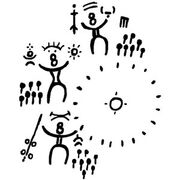This article takes a strictly historical view. Those of a metaphysical bent should proceed at once to Indwelling Harmonic Synthesis and trouble good historians no more.
The term First Gods is used sometimes as a term for those full divines extant at the beginning of human civilisation, sometimes for the first such beings to walk the planet, and often for the specifically Amfalian subset of either of these. These categories are generally conflated in the minds of anybody not especially interested in the subject; and since the Encyclopedia's editors (and their donors) have expressed themselves firmly on the subject, we shall pass over the fascinating topics of non-Amfalian gods and paleodivinities, and confine ourselves to treatment of that which everyone knows already; likewise, regional names for gods will not be discussed.
The Perfections[]
According to the bulk of religious texts, the First Gods manifested at some period between 30,000 and

This 11,000 year-old petroglyph from Mara Canyon depicts Knedun, Yamari and an unidentified deity leading their clans in a ritual dance.
15,000ya. Beings of vast power but (usually) human form, they are credited with instructing mankind in the nine Perfections, thus turning them from savages into real (that is, city-building) people. Amfalian faiths have always agreed on this number, and that the first six were agriculture, writing/mathematics, bronze, sewage treatment, brewing and worship; but only around the time of the Great Interregnum did patrilineal marriage, criminal law and the possibility of human Godhood become established in the orthodox canon. A dizzying variety of so-called Nineless sects rejected all or part of the final trinity (most notably the Ama Hazekh, who preferred the wheel, non-procreative sex, and a very complicated afterlife), until an official policy of eradication under Princess Orithia was quietly completed under the Godking.
Archaeological and linguistic approaches generally confirm that agriculture, brewing and bronze arose very close to the time of the first cities; however, things that look awfully like worship considerably predate this period, and we've no evidence for anything vaguely resembling writing or sewers until about 10,000ya. (The oldest texts that tell the story of the First Gods are probably no more than 3,000 years old. Art that can be linked to individual gods is at least 12,000 years old, but for half that the only recognisable figures are Knedun, Amabab and Yamari, and there are no depictions of the complete set until about 5,000ya.)
The Nine Cities[]
In the standard story, the First Gods founded the Nine Cities; each was created by one God and given as a gift to another. The exception was Asyi, who was so proud of her city Analur that she refused to give it up; the chain was thus broken, with Asyi holding both Knedun-Kep and Analur, while Kolis, left cityless, went into a rage and threw her lot in with nomads, indigents and other enemies of civilisation. (Depending on who's telling the story, sometimes she's responsible for non-Amfalian cultures too.)
Since we're doing our catechism, let's have the approved list:
- Asyi (patron of Knedun-Kep and Analur)
- Kolis (all-purpose bogeywoman)
- Yaca (patron of Kolikoli; male in orthodoxy, female or hermaphroditic in numerous premodern traditions)
- Yamari (bride of Yaca; patron of Yacata City)
- The Voiceless King (patron of Erissa)
- Amabab the Runner (patron of the Labyrinth Canals)
- Edergis (patron of Maban; lover of Yamari, which relationship features in innumerable examples of instructive pottery)
- Tsa (patron of Giragis; does a lot of smiting)
- Knedun (patron of Tsabava, the Seriously Creepy one)
Ever since, every two-bit warlord, election-wary mayor and caviling priest has declared that their hometown was

Not Analur, alas.
one of the Nine Cities; history records over 140 claimants for Analur alone. Erissa is the only known site that was continuously inhabited up to the modern period. It's probably even money that Knedun-Kep is the submerged ruin of Pretosh, the Beaton Ossuary is a tantalising candidate for Yacata City, and the Xepheryte capital will probably turn out to be Maban just as soon as the region quiets down enough for archaeologists to do any systematic work. Despite centuries of searches, excavations and conspiracy theories, there are no respectable candidates for the other five cities. There is a possibility that modern methods will find them in the deep ocean, or beneath a lava-bed, dune system, or glacier; it is also entirely possible that the Nine Cities were the brainchild of some ancient priest with a thing for symmetry.
Going Inside, and After[]
After a benificent and lengthy reign - numbers from one hundred to five thousand years are cited - the First Gods went inside, and this is generally where religious agreement ends. In light of subsequent events, it is probably best to give some credence to at least the general pattern of the Divine Blood-like myths that follow. More controversially, many faiths and cultures have credited local figures with full divinity. Although the usual tendency is to credit Mandri as being without precedent, a number of pre-modern claimants to human godhood accomplished similar degrees of power; my editors inform me that this is meant to be a popular encyclopedia and that there is no room for extended treatment of such distressing subjects, so I will refer the curious to Naming and Namelessness: Theonymic Reframing as Instrument of Power (Poitier & Merit, Grantchester University Press), particularly Chapters 4-7.
Cited[]
- Beaton Ossuary
- Divine Blood
- Erissa
- The Great Interregnum
- Indwelling Harmonic Synthesis
- Nineless
- Xepherytes
This phantom was created by Luddo Kaufmann. He cannot write this article.
Dibs. -- Tsawac Poitier